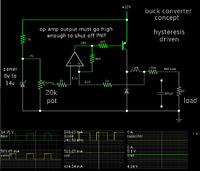T
treez
Guest
Hello,
Please could you help to define what circuit elements are (and which are not) in the feedback control loop of this SEPIC LED driver…………….
https://i46.tinypic.com/jttquc.jpg
V(in) is fixed at 6V.
Input current is regulated by the loop.
Output voltage could be anything between 5V and 40V.
Input power is limited to 7W.
The converter is a SEPIC , but I believe that the actual converter topology could have been anything, and the control loop would not change…is this true?
I mean, the converter’s power stage and output capacitors simply are not in the feedback loop…do you agree?
The feedback loop simply involves the input capacitors..is this true?
Please could you help to define what circuit elements are (and which are not) in the feedback control loop of this SEPIC LED driver…………….
https://i46.tinypic.com/jttquc.jpg
V(in) is fixed at 6V.
Input current is regulated by the loop.
Output voltage could be anything between 5V and 40V.
Input power is limited to 7W.
The converter is a SEPIC , but I believe that the actual converter topology could have been anything, and the control loop would not change…is this true?
I mean, the converter’s power stage and output capacitors simply are not in the feedback loop…do you agree?
The feedback loop simply involves the input capacitors..is this true?
